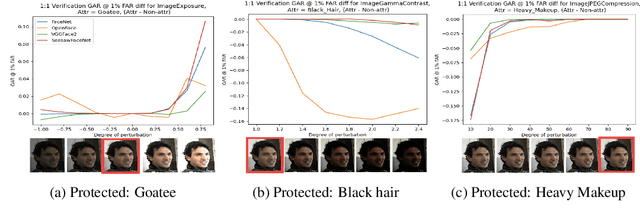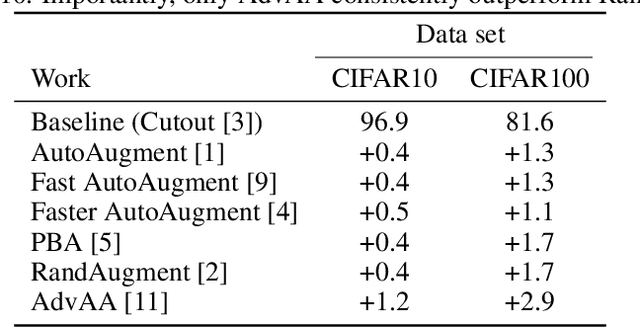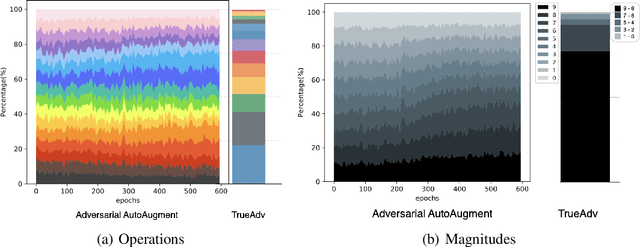Nicholas Apostoloff
Is Your Model Fairly Certain? Uncertainty-Aware Fairness Evaluation for LLMs
May 29, 2025Abstract:The recent rapid adoption of large language models (LLMs) highlights the critical need for benchmarking their fairness. Conventional fairness metrics, which focus on discrete accuracy-based evaluations (i.e., prediction correctness), fail to capture the implicit impact of model uncertainty (e.g., higher model confidence about one group over another despite similar accuracy). To address this limitation, we propose an uncertainty-aware fairness metric, UCerF, to enable a fine-grained evaluation of model fairness that is more reflective of the internal bias in model decisions compared to conventional fairness measures. Furthermore, observing data size, diversity, and clarity issues in current datasets, we introduce a new gender-occupation fairness evaluation dataset with 31,756 samples for co-reference resolution, offering a more diverse and suitable dataset for evaluating modern LLMs. We establish a benchmark, using our metric and dataset, and apply it to evaluate the behavior of ten open-source LLMs. For example, Mistral-7B exhibits suboptimal fairness due to high confidence in incorrect predictions, a detail overlooked by Equalized Odds but captured by UCerF. Overall, our proposed LLM benchmark, which evaluates fairness with uncertainty awareness, paves the way for developing more transparent and accountable AI systems.
Evaluating Gender Bias Transfer between Pre-trained and Prompt-Adapted Language Models
Dec 04, 2024Abstract:Large language models (LLMs) are increasingly being adapted to achieve task-specificity for deployment in real-world decision systems. Several previous works have investigated the bias transfer hypothesis (BTH) by studying the effect of the fine-tuning adaptation strategy on model fairness to find that fairness in pre-trained masked language models have limited effect on the fairness of models when adapted using fine-tuning. In this work, we expand the study of BTH to causal models under prompt adaptations, as prompting is an accessible, and compute-efficient way to deploy models in real-world systems. In contrast to previous works, we establish that intrinsic biases in pre-trained Mistral, Falcon and Llama models are strongly correlated (rho >= 0.94) with biases when the same models are zero- and few-shot prompted, using a pronoun co-reference resolution task. Further, we find that bias transfer remains strongly correlated even when LLMs are specifically prompted to exhibit fair or biased behavior (rho >= 0.92), and few-shot length and stereotypical composition are varied (rho >= 0.97). Our findings highlight the importance of ensuring fairness in pre-trained LLMs, especially when they are later used to perform downstream tasks via prompt adaptation.
Controlling Language and Diffusion Models by Transporting Activations
Oct 30, 2024Abstract:The increasing capabilities of large generative models and their ever more widespread deployment have raised concerns about their reliability, safety, and potential misuse. To address these issues, recent works have proposed to control model generation by steering model activations in order to effectively induce or prevent the emergence of concepts or behaviors in the generated output. In this paper we introduce Activation Transport (AcT), a general framework to steer activations guided by optimal transport theory that generalizes many previous activation-steering works. AcT is modality-agnostic and provides fine-grained control over the model behavior with negligible computational overhead, while minimally impacting model abilities. We experimentally show the effectiveness and versatility of our approach by addressing key challenges in large language models (LLMs) and text-to-image diffusion models (T2Is). For LLMs, we show that AcT can effectively mitigate toxicity, induce arbitrary concepts, and increase their truthfulness. In T2Is, we show how AcT enables fine-grained style control and concept negation.
Spatial LibriSpeech: An Augmented Dataset for Spatial Audio Learning
Aug 18, 2023



Abstract:We present Spatial LibriSpeech, a spatial audio dataset with over 650 hours of 19-channel audio, first-order ambisonics, and optional distractor noise. Spatial LibriSpeech is designed for machine learning model training, and it includes labels for source position, speaking direction, room acoustics and geometry. Spatial LibriSpeech is generated by augmenting LibriSpeech samples with 200k+ simulated acoustic conditions across 8k+ synthetic rooms. To demonstrate the utility of our dataset, we train models on four spatial audio tasks, resulting in a median absolute error of 6.60{\deg} on 3D source localization, 0.43m on distance, 90.66ms on T30, and 2.74dB on DRR estimation. We show that the same models generalize well to widely-used evaluation datasets, e.g., obtaining a median absolute error of 12.43{\deg} on 3D source localization on TUT Sound Events 2018, and 157.32ms on T30 estimation on ACE Challenge.
Towards a Perceptual Model for Estimating the Quality of Visual Speech
Mar 24, 2022



Abstract:Generating realistic lip motions to simulate speech production is key for driving natural character animations from audio. Previous research has shown that traditional metrics used to optimize and assess models for generating lip motions from speech are not a good indicator of subjective opinion of animation quality. Yet, running repetitive subjective studies for assessing the quality of animations can be time-consuming and difficult to replicate. In this work, we seek to understand the relationship between perturbed lip motion and subjective opinion of lip motion quality. Specifically, we adjust the degree of articulation for lip motion sequences and run a user-study to examine how this adjustment impacts the perceived quality of lip motion. We then train a model using the scores collected from our user-study to automatically predict the subjective quality of an animated sequence. Our results show that (1) users score lip motions with slight over-articulation the highest in terms of perceptual quality; (2) under-articulation had a more detrimental effect on perceived quality of lip motion compared to the effect of over-articulation; and (3) we can automatically estimate the subjective perceptual score for a given lip motion sequences with low error rates.
FedEmbed: Personalized Private Federated Learning
Feb 18, 2022



Abstract:Federated learning enables the deployment of machine learning to problems for which centralized data collection is impractical. Adding differential privacy guarantees bounds on privacy while data are contributed to a global model. Adding personalization to federated learning introduces new challenges as we must account for preferences of individual users, where a data sample could have conflicting labels because one sub-population of users might view an input positively, but other sub-populations view the same input negatively. We present FedEmbed, a new approach to private federated learning for personalizing a global model that uses (1) sub-populations of similar users, and (2) personal embeddings. We demonstrate that current approaches to federated learning are inadequate for handling data with conflicting labels, and we show that FedEmbed achieves up to 45% improvement over baseline approaches to personalized private federated learning.
Fair SA: Sensitivity Analysis for Fairness in Face Recognition
Feb 09, 2022



Abstract:As the use of deep learning in high impact domains becomes ubiquitous, it is increasingly important to assess the resilience of models. One such high impact domain is that of face recognition, with real world applications involving images affected by various degradations, such as motion blur or high exposure. Moreover, images captured across different attributes, such as gender and race, can also challenge the robustness of a face recognition algorithm. While traditional summary statistics suggest that the aggregate performance of face recognition models has continued to improve, these metrics do not directly measure the robustness or fairness of the models. Visual Psychophysics Sensitivity Analysis (VPSA) [1] provides a way to pinpoint the individual causes of failure by way of introducing incremental perturbations in the data. However, perturbations may affect subgroups differently. In this paper, we propose a new fairness evaluation based on robustness in the form of a generic framework that extends VPSA. With this framework, we can analyze the ability of a model to perform fairly for different subgroups of a population affected by perturbations, and pinpoint the exact failure modes for a subgroup by measuring targeted robustness. With the increasing focus on the fairness of models, we use face recognition as an example application of our framework and propose to compactly visualize the fairness analysis of a model via AUC matrices. We analyze the performance of common face recognition models and empirically show that certain subgroups are at a disadvantage when images are perturbed, thereby uncovering trends that were not visible using the model's performance on subgroups without perturbations.
FORML: Learning to Reweight Data for Fairness
Feb 03, 2022



Abstract:Deployed machine learning models are evaluated by multiple metrics beyond accuracy, such as fairness and robustness. However, such models are typically trained to minimize the average loss for a single metric, which is typically a proxy for accuracy. Training to optimize a single metric leaves these models prone to fairness violations, especially when the population of sub-groups in the training data are imbalanced. This work addresses the challenge of jointly optimizing fairness and predictive performance in the multi-class classification setting by introducing Fairness Optimized Reweighting via Meta-Learning (FORML), a training algorithm that balances fairness constraints and accuracy by jointly optimizing training sample weights and a neural network's parameters. The approach increases fairness by learning to weight each training datum's contribution to the loss according to its impact on reducing fairness violations, balancing the contributions from both over- and under-represented sub-groups. We empirically validate FORML on a range of benchmark and real-world classification datasets and show that our approach improves equality of opportunity fairness criteria over existing state-of-the-art reweighting methods by approximately 1% on image classification tasks and by approximately 5% on a face attribute prediction task. This improvement is achieved without pre-processing data or post-processing model outputs, without learning an additional weighting function, and while maintaining accuracy on the original predictive metric.
Challenges of Adversarial Image Augmentations
Dec 03, 2021



Abstract:Image augmentations applied during training are crucial for the generalization performance of image classifiers. Therefore, a large body of research has focused on finding the optimal augmentation policy for a given task. Yet, RandAugment [2], a simple random augmentation policy, has recently been shown to outperform existing sophisticated policies. Only Adversarial AutoAugment (AdvAA) [11], an approach based on the idea of adversarial training, has shown to be better than RandAugment. In this paper, we show that random augmentations are still competitive compared to an optimal adversarial approach, as well as to simple curricula, and conjecture that the success of AdvAA is due to the stochasticity of the policy controller network, which introduces a mild form of curriculum.
Self-conditioning pre-trained language models
Sep 30, 2021



Abstract:We study the presence of expert units in pre-trained Transformer-based Language Models (TLMs), and how they can be used to condition text generation to contain specific concepts. We define expert units to be neurons that are able to detect a concept in the input with a given average precision. A concept is represented with a set of sentences that either do or do not contain the concept. Leveraging the OneSec dataset, we compile a dataset of 1344 concepts that allows diverse expert units in TLMs to be discovered. Our experiments demonstrate that off-the-shelf pre-trained TLMs can be conditioned on their own knowledge (self-conditioning) to generate text that contains a given concept. To this end, we intervene on the top expert units by fixing their output during inference, and we show experimentally that this is an effective method to condition TLMs. Our method does not require fine-tuning the model or using additional parameters, which allows conditioning large TLM with minimal compute resources. Furthermore, by intervening on a small number of experts in GPT2, we can achieve parity with respect to two concepts at generation time. The specific case of gender bias is explored, and we show that, for given contexts, gender parity is achieved while maintaining the model's perplexity.
 Add to Chrome
Add to Chrome Add to Firefox
Add to Firefox Add to Edge
Add to Edge